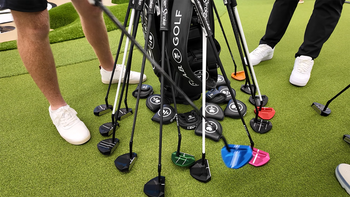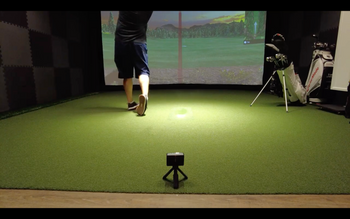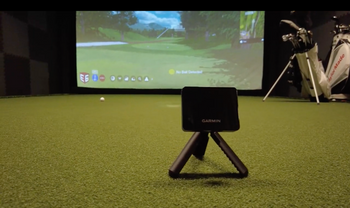You know what caught me off guard this week? Garmin's new Approach G20 Solar – a GPS that runs on sunshine. Yeah, you heard that right.
I'll be honest, when this $300 gadget landed on my desk for testing, I thought "seriously, who asked for this?" But after taking it out for a few rounds, I've got some surprising takes to share.
Here's the deal: this thing charges itself while you're playing. That built-in solar panel means you're not scrambling for a charging cable the night before your Saturday tee time. Pretty slick, right?
But let's talk about what really matters – does it actually help your game? The short answer is yes, though maybe not in the ways you'd expect.
The G20 gives you precise yardages to the front, middle, and back of greens. No more guessing whether that 150-yard marker is accurate or eyeballing distances from sprinkler heads. You get exact numbers every time, which means you're pulling the right club instead of coming up short because you misjudged by 10 yards.
What I really dig is how it shows hazard distances too. You know that water carry on hole 14 that always makes you nervous? The G20 tells you exactly how far you need to hit it to clear the drink. Same goes for bunkers and other trouble spots.
The battery life is where this unit shines – literally. During my testing, I played 36 holes over a weekend without plugging it in once. The solar charging kept it topped off the whole time. Compare that to phone apps that drain your battery by the back nine.
Now, I won't sugarcoat it – for three hundred bucks, you're not getting all the bells and whistles of fancier models. There's no slope adjustment or wind tracking. It's basically a super-reliable yardage machine that never needs charging.
Is it worth your money? If you're tired of dead GPS watches or killing your phone battery with golf apps, absolutely. But if you want advanced features like club recommendations or shot tracking, you might want to look elsewhere.
Bottom line: The G20 does one thing really well – it gives you accurate distances without the charging hassle. For the golfer who just wants reliable yardages round after round, this solar-powered workhorse delivers.
Table of Contents
Key Features
Solar-Powered Performance : This GPS charges itself while you play, using a built-in solar panel that gains 19 minutes of battery from just 5 minutes in direct sunlight. You'll never worry about dead batteries mid-round again.
Magnetic Mounting System : The G20 features a smart magnetic design that clips securely to your cart or bag. At only 3.8 ounces, it's light enough to hang from a carabiner without weighing you down during your walk.
Precise GPS Accuracy : Get exact distances to front, middle, and back of greens, plus all hazards on the hole. Garmin's GPS technology delivers tour-level accuracy that helps you pull the right club every single time.
Weather-Resistant Display : The high-contrast black-and-white screen cuts through glare and stays readable in rain or shine. Big Numbers mode makes checking yardages quick and easy when you're keeping pace of play.
Garmin Golf App Integration : Connect to track scores, analyze stats, and sync with other Garmin devices. View wind data and manage all your golf tech in one convenient app ecosystem.
Garmin Approach G20
Experience precision and confidence on every shot—Garmin Approach G20 elevates your golf game instantly.
Design and Technology
So you crack open that familiar gray box from Garmin - nothing fancy, right? They stick with the same no-nonsense packaging for their whole Approach lineup. Look, when you've got Garmin's track record, you don't need flashy boxes to sell your stuff.
Inside, you'll find the basics - the G20 unit, a belt clip, USB-C charger, and instructions. That's it. No extra bells and whistles.
Here's what caught me off guard though - this thing's way more compact than you'd think. We're talking 2.1 x 3.5 x 0.7 inches, and it barely tips the scales at 3.8 ounces naked or 5.1 ounces with the clip attached.
The kicker? This bad boy packs solar charging tech into that tiny frame. You'd figure something with a solar panel would be chunky, but nope - they nailed the size. It's actually perfect for clipping on your bag or belt without feeling like you're hauling extra gear around the course.

Effortless Portability: The G20’s Clip-On Edge
You'll love how the G20 sticks right on your cart with its built-in magnet - works just like that Bushnell Phantom 3 that everyone's been talking about. Actually, when you're shopping around, you'll probably compare these two more than any other models out there.
Here's what's clever about the setup - they give you this handy clip that's got its own magnet too. You just snap the device onto the clip and boom, you're ready to roll. No fumbling around trying to attach anything complicated.
When I walked the course with my bag, I hooked the G20's clip to a carabiner and let it hang from my bag strap. Super convenient setup because you can just glance down mid-stride and check your yardage without breaking your rhythm. The whole thing felt natural, like it was designed by someone who actually plays golf and gets what we need out there.
Exploring the Solar-Powered Capabilities of the Approach G20
You know what blew my mind about the G20? There's this solar tracking screen that tells you exactly what's happening with the sun's power in real-time. You can check your remaining battery, see how strong the sunlight hitting it is, and track your daily solar gains - pretty wild stuff.
Here's what happened when I unboxed mine - I walked outside and stood in the sun for maybe five minutes, tops. The thing gained 19 minutes of battery. Just like that. No joke.
I'll be honest with you - when I heard about this solar charging deal, I figured it was just marketing fluff. You know how these companies love their buzzwords. That tiny panel on top? I didn't think it'd do squat for keeping the device running.
Boy, was I wrong.
Fresh from the package, this sucker already showed six days of juice left. After seeing how fast sunshine tops it off, I'm thinking battery anxiety is officially dead with this device. You could probably leave it on your bag all season and never worry about it dying.
Of course, if you're playing in Seattle or something and need juice fast, they stuck a USB-C port on the side. Quick charge and you're back in business.
That solar feature I was ragging on? Yeah, I take it all back. It's legit useful, not just some fancy add-on to jack up the price.
Speaking of price though - let's not sugarcoat it. The G20 costs serious money for what's essentially a GPS watch. You're gonna feel that credit card hit.
So here's the million-dollar question - should you actually buy this thing?

Is the Garmin Approach G20 Worth the Investment?
You're looking at dropping three Benjamins on the G20, which feels pretty hefty for what's basically a straightforward GPS unit. For that kind of cash, you'd think you're getting all the bells and whistles - maybe a slick color display or those detailed green layouts that show every bunker and hazard.
Here's the deal though - the G20 keeps things simple. You're getting the same GPS accuracy you'd find in Garmin's cheaper G12 handheld or their S12 wrist unit. Speaking of the S12, it's essentially the G20 shrunk down to fit on your wrist. Sure, you lose the solar charging, but you're talking identical course data and yardages.
If you're shopping around, definitely check out the S12 first. You're choosing between wearing it or carrying it, but the actual golf features? Pretty much identical. Plus, at two hundred bucks, you're saving a hundred that could go toward new wedges or a dozen ProV1s.
Want to stick with that $300 budget? The new S44 watch gives you way more bang for your buck. You get full-color hole views, see the shape of every green, and tons of extra features the G20 doesn't have. The trade-off? No so
Seamless Button Controls: Navigating the G20 with Ease
You control this unit with four physical buttons - no touchscreen here. Two buttons sit on the left for scrolling up and down through your options, with the up button pulling double duty as your power switch. Over on the right, you've got your main select button for confirming choices, plus a back button underneath to retreat to previous screens.
Here's the thing - navigating with actual buttons just works better when you're out there trying to dial in your yardage. Your hands might be sweaty, muddy, or you're wearing rain gloves - doesn't matter. Those buttons respond every time, unlike touchscreens that get finicky when wet. Sure, at this price point, having both options would've been sweet, but honestly? The button setup feels more reliable when you need it most.
The screen itself really surprised me. Yeah, it's black and white - no fancy colors - but man, you can read this thing perfectly no matter what Mother Nature throws at you. Blazing sun creating glare everywhere? No problem. Those dark storm clouds rolling in during the back nine? Still crystal clear. Rain pelting down while you're trying to figure out if you can clear that water hazard? The display cuts right through it.
If you're squinting at yardage books or struggling to see your buddy's rangefinder numbers, there's a Big Numbers mode that'll save your round. It blows up those front, center, and back distances so you can grab your yardage at a glance - perfect when you're holding up the group behind you or your eyes are tired after 14 holes.
The whole interface feels like someone actually thought about what you need during a round. Within seconds, you're getting the info you want without fumbling through complicated menus or accidentally hitting the wrong spot on a screen. That simplicity means more time focusing on your shot and less time wrestling with technology.

Connecting the G20: Effortless Sync with the Garmin App
You know what's pretty sweet about the G20 Solar? It connects right up with Garmin's Golf app, and honestly, they've built something special with their whole lineup. If you're the type who's gone all-in with their gear - maybe you've got their launch monitor and rangefinder too - having everything sync up in one spot just makes sense.
Now here's the deal - this thing can track your scores and stats, but let's be real for a second. When I'm out there playing, the last thing I want to do is walk back to my cart after every shot to punch numbers into a handheld device. That's where watches have the edge, right? They're always on your wrist, ready to go. With the G20, you'd have to make that extra effort each time, and I just don't see that happening consistently.
What this device really nails is the yardage game. That's its bread and butter, and honestly, that's probably why you're thinking about getting one anyway. The GPS accuracy? Spot on every single time. Garmin's got this stuff down to a science - they're basically the gold standard when it comes to GPS tech on the course.
Here's something interesting - connect it to the app and you'll get wind info too. But I've gotta level with you here. Wind data sounds great in theory, but it's kinda sketchy in practice. Think about it - where's that information actually coming from? Could be some weather station miles away from where you're standing. Plus, you know how wind swirls differently from one hole to the next, especially if you're playing a course with lots of trees or elevation changes.
Bottom line? The G20 Solar is killer for getting accurate distances, and if you're already using other Garmin stuff, it fits right into your setup. Just don't expect to use all those fancy stat-tracking features unless you're way more disciplined than most of us weekend warriors.
A Minor Drawback: My Honest Take on the Garmin G20 GPS
Look, at three hundred bucks, you'd expect something pretty impressive from the G20, right? But here's where it gets a bit disappointing - those hole layouts are about as basic as it gets. You're basically looking at the same black-and-white display you'd see on the cheaper G12 and S12 models. No fancy graphics, no detailed visuals - just bare-bones information on a plain screen.
Now don't get me wrong, this thing isn't completely useless. You'll still get your standard yardages to the front, middle, and back of greens. Plus, you can cycle through different pin positions if your course updates them daily, which helps dial in those approach shots. That's solid stuff for improving your club selection.
The hazard info is where things get a little wonky though. Instead of showing you an actual map of the hole (like where that water is relative to your ball), you're stuck scrolling through what's basically a list of distances. Honestly, half the time you're squinting at the screen trying to figure out if that 150-yard number is for the bunker on the left or the creek that crosses the fairway.
Here's the kicker - most basic GPS units and entry-level watches give you this same level of info, and they cost way less. The G20's big selling point is supposed to be that solar charging feature. But if they loaded it up with colorful maps and detailed graphics, that solar panel probably couldn't keep up with the battery drain.
So you're basically paying premium money for unlimited battery life, not premium features. If you're the type who forgets to charge your devices or plays 36 holes every weekend, maybe that trade-off makes sense. But for your average weekend warrior? That's a tough pill to swallow at this price point.
Our Experience
So you're thinking about dropping three hundred bucks on the Garmin G20? Let me break it down for you.
Here's the deal - this little gadget does some pretty cool stuff. You can clip it to your belt or toss it in the cart, and you're good to go. The solar charging actually works way better than you'd think. I was skeptical at first, but this thing stays juiced up without constantly hunting for outlets.
But let's be real about what you're getting. This isn't some fancy touchscreen with 3D flyovers. You're getting distances to the front, middle, and back of the green. That's pretty much it. And yeah, that's all some folks need, but here's where it gets tricky.
You could grab a Bushnell Phantom 3 for half the price and get basically the same distance info. Sure, you'd miss out on Garmin's whole setup where you can track your rounds and stats through their app. If you're already using Garmin stuff or you actually want to dig into your scoring patterns, then maybe the extra cash makes sense.
Now here's another thought - if you're already willing to spend three bills, why not throw in another two hundred and get the G80? That thing's got color maps showing you exactly where the bunkers and water are. Plus - and this is pretty sweet - it doubles as a launch monitor. Just plop it down behind your ball at the range and boom, you're getting carry distances and swing data. Is it Tour-level accurate? Nah. But it'll tell you if your 7-iron is flying 150 or 165, which is honestly all most of us need.
The G80's been around for a while though. No fancy magnetic mount or some of the newer bells and whistles Garmin's putting on their latest stuff. But that bigger screen sure is nice when you're trying to see those hole layouts.
Me? I'm rocking a Garmin watch these days. Gets me everything I need right on my wrist - distances, shot tracking, the whole nine yards. But I get that not everyone wants to wear a watch while they play.
Bottom line - the G20 does what it promises. Simple distances, solar power that actually works, and access to Garmin's tracking system if you're into that. Is it the best bang for your buck? That's where things get fuzzy. At three hundred, you're paying a premium for the Garmin name and that solar feature. But if those things matter to you, it's a solid piece of kit that won't let you down.
Garmin Approach G20
Experience precision and confidence on every shot—Garmin Approach G20 elevates your golf game instantly.
Is the Garmin Approach G20 Worth It?
Absolutely, while the Garmin Approach G20 is a great product, there are a few pros and cons that you need to be aware of: On the plus side, the Garmin Approach G20 offers a user-friendly interface and accurate GPS mapping, making it easier to navigate the course. However, it may lack some advanced functionalities found in higher-end models, such as the garmin approach r50 features, which include enhanced metrics and customizable settings. It's essential to weigh these factors when deciding if the G20 meets your golfing needs.
Pros:
Solar charging actually works - gained 19 minutes of battery from just 5 minutes in the sun, meaning you'll never scramble for a charger before your round
Rock-solid GPS accuracy with precise yardages to front, middle, and back of greens, plus hazard distances to help you pick the right club every time
- Super portable at just 3.8 ounces with magnetic mounting that clips easily to your cart or bag, letting you check distances without breaking stride
Cons:
Premium for basics - At $300, you're paying premium prices for basic black-and-white displays when cheaper options like the Bushnell Phantom 3 offer similar features for half the cost
No color hole maps or detailed green layouts - just basic distance lists that make it tough to visualize where hazards actually sit
- Stat tracking requires walking back to your cart after every shot, making it way less convenient than wrist-worn alternatives
Frequently Asked Questions
How long does the battery last on the Garmin Approach G20?
The G20 showed six days of battery life straight out of the box, and with solar charging during play, you can go 36 holes over a weekend without plugging it in. The solar panel keeps it topped off while you're on the course.
What distances does the G20 provide during a round?
You get exact yardages to the front, middle, and back of every green, plus distances to hazards like water carries and bunkers. It also lets you adjust for different pin positions if your course updates them daily.
Can the G20 connect to other Garmin devices and apps?
Yes, it syncs with the Garmin Golf app where you can track scores and stats. If you've got other Garmin gear like their launch monitors or rangefinders, everything integrates in one place for complete game tracking.
How does the G20 compare to Garmin's S12 watch?
They share identical GPS accuracy and course data - the main difference is form factor. The S12 goes on your wrist for $200 but lacks solar charging, while the G20 clips to your bag or cart for $300 with unlimited solar power.
Is the display readable in bright sunlight or rain?
The black-and-white screen stays crystal clear in any conditions - blazing sun, storm clouds, or pouring rain. There's even a Big Numbers mode that makes distances super easy to read at a glance.
Conclusion
Look, the G20's a solid piece of gear that does exactly what it promises - gives you dead-on yardages without the charging hassle. That solar panel's no gimmick, and if you're the type who's always forgetting to juice up your devices or playing 36 every weekend, this thing's your new best friend. But at three hundred bucks for basic distance info, you're really paying for convenience and the Garmin name. If you just need yardages and don't mind charging once a week, grab the S12 watch for two hundred and call it a day. But if unlimited battery life makes you sleep better at night and you've got the cash to spare, the G20 won't disappoint - just don't expect fancy graphics or Tour-level features at this price point.






